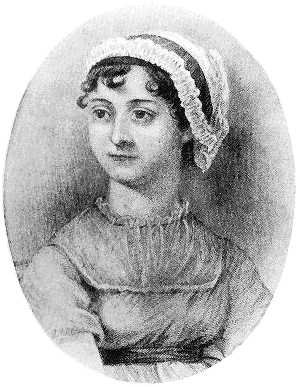TW Column by Emily Toth
“Make It Plain, Jane!”

“Herewith I commence,” Jane Austen may have thought when she wrote this sentence in her usual way—secretly, underneath blotter paper in the family sitting room: It is a truth universally acknowledged, that a single man in possession of a good fortune, must be in want of a wife.
That sentence, the beginning of Pride and Prejudice, works as a tweet (under 140 characters), but not as flash. It violates most of today’s rules for being transparent, minimalist, and down-to-earth—what you’re supposed to do in order to communicate quickly in our speed-driven, barbarous times.
My previous sentence violates all those rules, too. But I do know them, and here’s where Jane Austen goes awry (poor Jane). Note that I’m providing a listicle because I am so au courant and up to date.
Jane’s Sins
1. Impersonal construction (“It is a truth”)
2. Adverb (“universally”)
3. Passive voice (“is…acknowledged”)
4. Two words where one will do (“single man” instead of “bachelor”)
5. Three words where two will do (“in possession of” instead of “who has”)
6. Two prepositional phrases where neither is necessary (“in possession of” instead of “having”)
7. More prepositions instead of a simple verb (“must be in want of” instead of “needs”)
8. Vague adjective that tells instead of shows (“good fortune” instead of “a million dollars”)
Now, if I break it down, I get: Rich bachelor needs wife.
“But that’s not my story!” Jane Austen might protest. (If she can protest, she’s got plenty of other grievances, too. Lately, she’s been in stories with vampires, zombies, and who knows what all else. Lots of action for a lady sewing sedately in the family sitting room.)
 None of the above is Jane Austen’s story, either. She had one overall subject that she brilliantly subverted and satirized: the marriage plot, with all its perils for women, especially the young and the reckless. (It is a truth universally noted that Jane Austen did not marry.)
None of the above is Jane Austen’s story, either. She had one overall subject that she brilliantly subverted and satirized: the marriage plot, with all its perils for women, especially the young and the reckless. (It is a truth universally noted that Jane Austen did not marry.)
What Jane Austen portrayed was not a fast-paced world of flash and dash, in which people said exactly what they meant (“let’s hook up” or “you suck”). Her world required circumlocution and tact. It also allowed people to save face.
And that, it seems to me—and, yes, I know you shouldn’t begin a sentence with a conjunction; nor should you make the sentence so long that you have to repeat the beginning—is trouble. The problem with being succinct or tweety or flashing your story is that you can’t blot out things you maybe shouldn‘t have said so bluntly. You might be rude. You might lose your nuances.
Also (another conjunction that shouldn’t begin a sentence), what would Jane Austen do after her novel began with “Rich guys need wifeys?”
She’d run out of space, as I have, for a 500-word column.
Toodles.
Art Information
- "The Vyne House & Lake" © Simon Q; Creative Commons license.
- "Portrait of Jane Austen" (late nineteenth-century engraving); public domain.
 Emily Toth is a contributing writer at Talking Writing. Her column “Nothing but the Toth” appears regularly in TW. She also writes “Ms. Mentor,” the online academic advice column for the Chronicle of Higher Education and has published biographies of Kate Chopin and Grace Metalious.
Emily Toth is a contributing writer at Talking Writing. Her column “Nothing but the Toth” appears regularly in TW. She also writes “Ms. Mentor,” the online academic advice column for the Chronicle of Higher Education and has published biographies of Kate Chopin and Grace Metalious.
